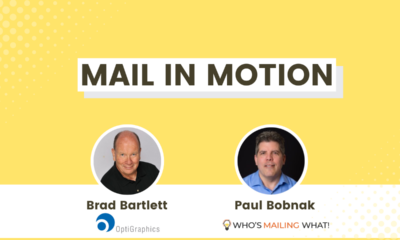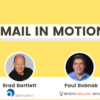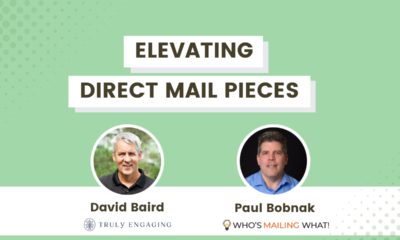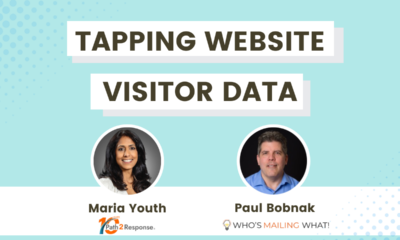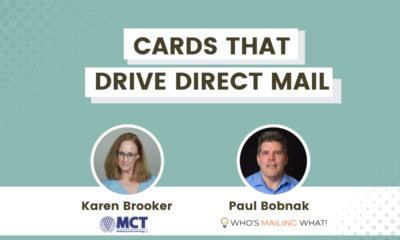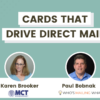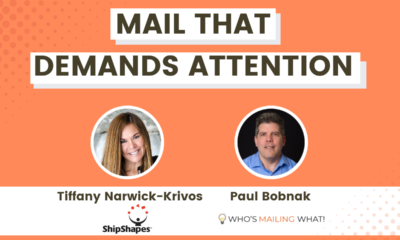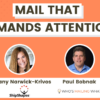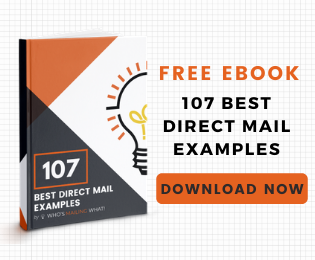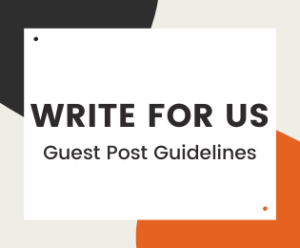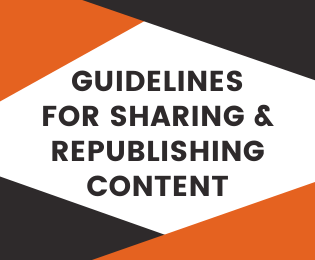MEET THE MAILERS
Meet the Mailers: The Value of Accurate Direct Mail Data
In this episode, we talked with Melissa about data and its role in direct mail, the company’s “1-10-100” and how it relates to estimating losses from bad addresses, etc.
In this episode, I talked with Greg Brown, VP of Marketing of Melissa. Melissa is a leading provider of global contact data quality and identity verification solutions.
We discussed all things data and its role in direct mail that is relevant to customers. He explained the company’s “1-10-100” and how it relates to estimating losses from bad addresses.
As Greg explained:
The cost of bad data is real and measurable. It costs billions, if not more than that, for companies every year.
 Greg BrownVP of Marketing
Greg BrownVP of Marketing
Melissa
Among the many topics we covered:
- His marketing background & day-to-day role at Melissa
- Why Melissa’s direct mail catalog is an important part of its marketing strategy
- The challenge of bad data
- Responsibly using data
- Direct mail’s value proposition today
- Trends in direct mail today
Here are some questions and answers from our conversation (edited for clarity and space):
- Can you talk about the solutions that Melissa offers to marketers?
Since 1985, and I’m sure a lot of your listeners and viewers are familiar with Melissa, we’ve been harnessing the value of accurate customer data, whether that’s represented by a zip code, postal code, an email address, verifying a particular person at an address, or updating a mailing address particular to a specific person.
You know, these are the kind of tools that help people like me and marketing departments continue to deliver relevant messaging to customers while minimizing cost to the business. And also protecting the brand, not only from fraud and waste, but also just kind of the brand image, making sure that the message that you spend time and effort in is as relevant as it can be when you deliver it to your particular audience. Essentially, what we offer now is kind of a one-stop shop for marketers …the entire chain of things that they would need is from finding fresh new leads identifying the defining attributes of their best customers so that they can kind of go out into the market and look for more that are just like them.
And then, lots of different tools to reduce costs and improve communications by improving the deliverability of the mailings, re-sorting them for savings, and just kind of cutting the cost of marketing through improving the overall quality of customer data.
- Back in the late nineties, when I started running Who’s Mailing What! for Target Marketing, there was this catalog that Melissa sent out to market itself, and I think it’s remarkable that it’s still mailed today. Why is it that a print product like that still reaches a B2B audience?
Well, I think, you know, a little bit of that is obviously we want to not do as we say, [but] do as we do.
So, we support the direct mail industry. And we have, for gosh, almost 37, 38 years. And we believe in the medium. So we use it ourselves, obviously, but the most important component of that is the impact that physical direct mail has… the best ROI response rates and conversions.
[I]t’s physical, it’s visual, and it’s just more permanent for a recipient to receive, especially now; we’ve seen a lot of people, a lot of marketers kind of move away from direct mail. So there’s actually less competition in the mailbox than ever before, whereas you think that the average person’s receiving upwards of 120 emails a day, there’s just a lot less volume.Research just found recently that the average lifespan of a direct mail piece is 17 days. And you’re, and you’re lucky if the typical email gets 17 seconds that a customer is considering it. Just think about all that – the activity of grabbing it from your mailbox, bringing it onto your kitchen counter or your desk.
It’s going to sit there. You’re going to be able to look at it multiple times, contemplate the message and it just has that physicality that I think just cannot be replicated in any other medium …I think, obviously email marketing is a strong component of any campaign, but it doesn’t take as much effort or intentionality. And I think that creates kind of a commensurate feeling on the recipient side that this marketer took this time and effort to get this particular message to me. So it just has a little bit more import when you receive it.
- Just how bad a problem is bad data costing companies? And what are some specific ways that you guys at Melissa help companies deal with that?
The cost of bad data is real and measurable. As you were saying, it costs billions if not more than that for companies every year. We have a kind of a diagram that we talk about. It’s called the 1-10-100 rule. The idea is that cleaning or capturing accurate data at the point of entry is going to cost you maybe, let’s say, a dollar per record, just to give at least a little bit of indication on that.
And then, if that bad data is not corrected, it’s going to kind of permeate through your business units: through your MDM, your ERP systems, your CRM, and it’s going to end up costing you about 10 [dollars] a record is what we estimate. And then, if it’s never really corrected at any time … you can’t market to it. You can’t sell to it. You can’t really do analytics or anything else. It’s just dead. And over the customer lifetime value, that’s going to equate to about a 100 dollars per record.
And then we see that just typically on average about 8 to 10 percent of records in the normal CRM are bad. That doesn’t mean that they’re completely worthless. But that may mean that they may be incomplete. They’re missing maybe the Zip+4. They may be missing a prefix or a telephone number or a directional on an address, they may be inaccurate, they may include addresses for customers that have moved, customers that are deceased, customers that are on a Do Not Mail list that you don’t know about, or they’re vacant, right?
These are really things that the marketers need to take into account, and look for tools that can help them not only at point of entry, capture the most accurate data possible, but understand that data goes stale very quickly. We’re fluid, we’re individuals, we’re people, we move around, we get married, we get divorced, we change jobs, we move our residences, etc.
So, trying to keep up with that kind of moving target is really imperative for marketers and obviously a challenge. So that’s why there’s lots of tools out there that can really help at the point of entry, make sure that you’re helping a customer, make sure that they’re entering their address in accurately, getting all the parts of the information that you need and then keeping up with them over time is really important.
- Data really offers marketers lots of ways that they can reach their customers and in different and interesting ways. So, one of the ones that’s pretty obvious is location and geographical data. What are some good ways that marketers can use those to market their brands?
Yeah, there’s really awesome ways to use location data, and two different aspects. I think, number one, especially for local businesses, being able to understand where most of your customers are. They’re probably in a very localized area, two or three or four or five miles outside of your business.
Being able to understand that, you can take advantage of what USPS has, which is called Every Door Direct [Mail], a program where you can essentially just saturate a carrier route, which is just essentially what it means. You know, the postal carrier is literally walking every resident in that particular route and delivering that mail piece, because it’s really systematic and ordered.
It’s easy for the post office to get those sorted, and they offer nice discounts for customers that are using that type of program. Where Melissa would kind of add on to that is not only delivering to every door, but adding on that personalization aspect of being able to identify an individual that lives at that residence and be able to specifically address that mail piece to that individual..
And that’s a really great way for your local haircutting business or dry cleaner, pizza, etc., to really get the word out about your operations, of promotion that you’re doing, etc., and really save significant amounts of money on the cost of direct mail, and concurrently with that is using location for more targeted marketing where you’re identifying maybe the demographic attributes of your customers and then trying to map out where they actually reside.
So then kind of marrying the location with these psychoanalytics and the demographics, including age, presence of children, household income, all of those things. You can develop some essential targeted marketing strategies where you can pinpoint your use of direct mail and maximize its effectiveness.
And how about programmatic and retargeting for digital marketers who want to reach into people with direct mail. We see that a lot more as well. So we’re looking at people that don’t convert. Maybe they visit your website, look at a few pages but they’re not maybe quite convinced or they haven’t really wanted to convert and either fill out a form or add something to a shopping cart.
You can kind of develop some interesting kind of attributes that then you can kind of marry up with your direct mail pieces and reach back out to them through a direct mail piece that then kind of ties them exactly right back to your website through a QR code, or a personalized URL that kind of already reinforced is the information that you’ve already kind of received from them to give them a really relevant touchpoint so that they can kind of reengage with you in the most meaningful way.
I think that’s so important in today’s time where we’re distracted. We have so many things going on. The more likely that a marketer in a brand can give me exactly what I need, exactly what I needed is so helpful in my life because I just don’t have a lot of time.
So these things kinda really do create a synergy between kind of the customer need, which is not only for a particular product or service or to meet a particular challenge, but it’s also, I just don’t have a lot of time to think about this, and please give me the most relevant messaging and that I can get at any given time. So it’s a really good marriage.
- One of the most exciting things about direct mail and marketing, in general, today is using data to improve the customer experience. Can you talk a little more about using all this data to create a more seamless 360-degree experience for customers?
Yeah, absolutely. I think that’s really the beautiful thing about direct mail right now is all of the ancillary tools that can be kind of curated or collated into the intentionality behind the piece. So you’ve got variable data that you can add into the piece.
We obviously talked about personalization and everybody wants to see their name on a mail piece as opposed to a “current resident”. Right now that doesn’t really resonate with me, but being able to add in other things that you know about that customer as far as maybe their buying habits or what they’ve been looking at on your website and be able to variably add those in as fields into a direct mail piece that looks seamless and consistent and delivers the exact kind of information that they’re looking for to take that next step is really important.
I think that – going back to the power of direct mail – is also understanding kind of the responsibility of direct mail that you’re spending some money and effort, production, printing costs, and postage on delivering a piece to somebody.
You want to obviously make sure that it delivers exactly the message that you’re looking for. And …you want to be able to also respect the wishes of the customer or the recipient…I think that really goes back to kind of that respect, showing that respect and you can do that through direct mail pieces.
So to see suppression, Do Not Mail suppression so that you’re honoring the wishes of the recipient. I’ve talked with a number of direct mailers at various shows that we’ve gone to. And one thing that does come up pretty often is they get calls from people that have pieces that have come and they’re addressed to deceased loved ones within the household.
And they’re always asking me, “What can we do about this?” Obviously, we take them out of our databases, right? “But are there other things that can be done about it?” And, you know … we do have a deceased suppression service.
Of course, that works off of death records and stuff like that to help clean up your mailing list, but it really kind of talks to the impact that direct mail pieces have. I cannot remember ever getting a call from somebody that was angry about an email that was addressed to maybe a deceased wife or husband; they’ll click the unsubscribe button and whatnot. But there’s another level of emotional connection and the expectation that I think a recipient has, that it really is powerful when they do receive those kinds of mail.
They want to reach out, and they want to let you know that “Please don’t do that.” That really kind of shows the power of direct mail and the opportunities not only to continue to deliver respectful, relevant messaging but also to help protect your brand image.
Just because of the power of direct mail.
- I think that actually sort of dovetails with where I was going to go next, which is talking about the value proposition of direct mail.
I think you hit on there a lot, which is creating an emotional connection.
[I]s it the paper? Is it the images and how the data is used? What is it that works? We’re human, right? We love hugs, we love physical connection, right? And it’s just a part of being human, being alive.And I think that’s the closest thing that you can duplicate from a marketing standpoint is that physicality that you get with direct mail. But also,I think understanding that we live in a digital age, right?
So that really tasks marketers to look at ways where they can integrate direct mail into more of their digital marketing campaigns to really take advantage of what both have to offer, right? So the convenience, obviously, digital – it is great.
That’s why I always talk about using QR codes, retargeting web visitors, and then allowing them obviously to get the direct mail piece and then re-engage digitally with the bran, are awesome things. Also[I] wanted to mention the USPS Informed Delivery program, which I think is fantastic, which allows people that have signed up – recipients – get email previews of direct mail pieces that are going to come into their mailbox.
It’s like when I talk with people about this, I always think of it as like it’s three bites at the apple, right?
It’s the direct mail piece that you’re going to get into the mailbox of your recipient. They’ve got the email preview, and also they have links to the content that is available off of that piece. So it’s just a wonderful thing that direct marketers should look at as far as really kind of utilizing some of those tools that the USPS has available now, and I also talk about the USPS promotional discounts that they’re offering as well for direct marketers to kind of really kind of get back into the mailbox and counter, obviously some of the issues that we have with the cost of postage and as you mentioned, the cost of materials, supply chain issues.
But the USPS has recognized that and does offer substantial discounts. And if you combine that with smart list hygiene tools, you can really reduce the cost that you’re spending per piece. And on top of that, when you have that good data, you’re able to attribute any actions after that to that piece.
From a tracking standpoint and ROI, being able to visualize the customer as you’re moving them kind of through the sales funnel and understand where the pain points are or the disengagement is really key. And that’s where I think that the marriage of direct and digital is really important.
You know, direct has a really good, I think, response and conversion rate, to get you to the next level. Then I think that’s where your digital campaigns can really help in kind of pulling down in qualifying the lead to get them over to maybe just a sales team to ultimately convert.
So, we talk about how you can re-engage lost leads or lapsed customers or re-target leads that didn’t convert. That’s exactly the point, maybe kind of warm them up, understand that they’re there, and willing to receive some information through a digital campaign that’s low cost.
And then when you see that there’s activity there and willingness to engage, that’s a really great opportunity to spend the time and effort into a targeted direct mail piece that really shows that you have as much interest in them as they have in you.
Here is our conversation (with all questions and answers). We’ve added timecodes for your convenience.
Thank you, Greg, for sharing your perspective and your expertise! To learn more about Melissa, visit their website at www.Melissa.com.
Your comments and ideas are very important to us in making your Who’s Mailing What! experience even better for you. Through these engaging talks, we hope you’ll take away practical tips, insights, and personal stories to inspire and build your own success.
If you have any feedback — or are interested in sharing your expertise and viewpoint with our wide and diverse audience on “Meet the Mailers” — please reach out to me. I’d love to hear from you!







